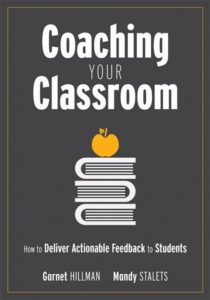Delivering Actionable Feedback to Students
Coaching Your Classroom: How to Deliver Actionable Feedback to Students
By Garnet Hillman and Mandy Stalets
(Solution Tree Press, 2019 – Learn more)

Actionable feedback and self-assessment are the keys to student ownership of learning and a shift from a focus on scores and grades to a focus on understanding and mastery.
So how do we make these shifts to help students be life-long, self-motivated learners who will be able to adapt to the rapidly changing landscape of jobs, responsibilities and issues they will face as adults?
We start by acting less as evaluators and more as coaches in our classrooms. And how do we do that? The answer to that question is clearly laid out in this book.

- to crafting high quality feedback
- to using various feedback methods
- to ensuring productive responses to feedback
- to students participating in self and peer assessment, and
- to students giving feedback to teachers.
Resource packed chapters
Each chapter contains sections on “why does this matter?”; “How does it work?”; “What does it look like?” (which includes teacher vignettes); and reflection questions to help us implement our learning from the chapter.
The book is also full of tables that clearly display the key information we need to know, as well as numerous forms for use in providing and using feedback. All this is also available for download from the companion webpage.
Shifting to a culture of feedback, where the focus is on learning and not evaluation (grades), takes time and practice, both for teachers and students and for their parents and caregivers. A successful shift also requires us to have some “coaching” to make this feedback culture a reality in our classroom.
Using this book as your coach
If you want to accomplish this, use this book as a “coach.” Read the whole thing first to get a good idea of the ultimate goal; then go back and work on each chapter of the book as you implement this.
The authors help us to shift our language, including clarifying the differences between feedback and scoring/grading, errors and mistakes, and tasks and skills. In the “why does it matter?” section of each chapter, the authors also help us understand how small differences can make a large difference in the long-term outcomes for our students.
If you want a classroom where learning and mastery are discussed daily, students take ownership of their learning, help each other to set goals, evaluate and monitor their progress, and take pride in their work rather than “checking off boxes to get a grade,” then this book is for you.
Coaching Your Classroom is also a well-formatted guide with lots of usable resources to help teachers at all levels of their careers. Imagine providing the kind of quality feedback all our students will respond to in positive, productive ways – taking ownership of their learning paths by creating their own reflections and self-assessments of their work as well as that of their peers. I definitely recommend this very useful book.
Dr. Laura Von Staden is currently a Middle School Gifted Math and Science teacher in Tampa, Florida. She serves on numerous committees in her school district, works closely with the local university, and writes curriculum. She is also a professional development consultant, and previously served as an Exceptional Student Education Specialist, and as a mentor.

































